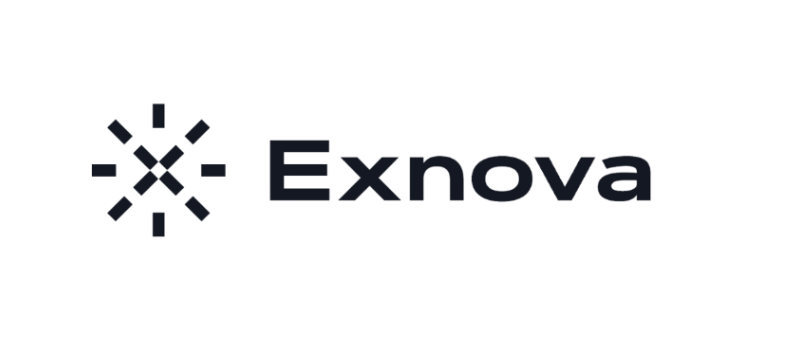
Best Ichimoku Strategy for Fast Profits
The best Ichimoku strategy is a system of technical indicators used to evaluate the market. This unique strategy provides trading signals of varying quality. Forex trading involves significant risk of loss. Although, with Ichimoku cloud trading, those losses are contained and kept small.
The Ichimoku system is a Japanese charting method and a method of technical analysis. Our team at Trading Strategy Tutorials have mastered this strategy for a long time.
The Ichimoku Index was published in 1969 by a reporter, Ichimoku Kinkou Hyo, in Japan. This candlestick trading technique has stood the test of time.
The name Ichimoku says a lot about the trading system, or at least it gives a description of the system.
Ichimoku = A glance, glance.
Kinkou = Balance, balance.
Hyo = Chart, Graph.
Ichimoku cloud trading attempts to identify a possible direction of price. It helps the trader to determine the best time to enter and exit the market by providing you with the trend. It gives you reliable support and resistance levels and the strength of these market signals.
The current….
Before we dive deeper into the Ichimoku Cloud strategy, let’s take a look at the necessary indicators to successfully trade the strategy.
The most popular Forex trading platforms use the Ichimoku Cloud indicator. The Ichimoku indicator plots all the necessary components to help visualize price action better. The Ichimoku Cloud is one of the most comprehensive technical indicators in modern use. Not surprisingly, it has quickly become the go-to indicator for forex traders worldwide.

In the Ichimoku cloud section we will give you an in-depth overview of the Ichimoku components.
So, before moving forward, let’s define all the Ichimoku Cloud components. We will look at how to correctly interpret the trade signals generated by this technical indicator.
Ichimoku Cloud explained
Ichimoku Hinko Hyo is an indicator momentum used to recognize the direction of a trend. It can also identify exact support and resistance levels. The Ichimoku Cloud Indicator consists of five main components that provide you with reliable trade signals:
- The Tenkan-Sen Line, also known as the Conversion Line, represents the midpoint of the last 9 candles. It is calculated according to the following Ichimoku formula: [(9 period high + 9 period low) / 2].
- The Kijun-Sen Line, also known as the Base Line, represents the midpoint of the last 26 candlesticks. It is calculated by the following formula: [(26 period high + 26 period low) / 2].
- Chiou Span , also known as Lagging Span, lags behind the price (as the name suggests). Lagging Span is redrawn for 26 periods.
- The Senkou Span A , also known as the Top Span A, represents one of the two boundaries of the Cloud, and it is the midpoint between the Transition Line and the Baseline: [(Conversion Line + Baseline) / 2 ]. This value is plotted for 26 future periods and it is the faster Cloud boundary.
- The Senkou Span B , or Top Span B, represents the Second Cloud boundary and it is the midpoint of the last 52 price bars: [(52 period high + 52 period low) / 2]. This value is plotted 52 periods into the future and it is the slower Cloud boundary.
- Chikou Span , represents the closing price and is plotted 26 days.
While the Ichimoku Cloud indicator consists of many different (five) lines, reading the chart is actually very easy. Using the trend lines mentioned above, you will then need to determine if Top Span A or Span B is currently higher.
Once the top Span A and Span B have been identified, the “cloud” component of this graph is shaded. When the leading Span B is above the top Span A, this shows traders that the bullish momentum is now increasing. When this is the case, the histogram will be colored green.
On the other hand, when Top Span A is below Top Span B, the underlying asset is likely to move in a negative direction. When this happens, the cloud will be colored red. Despite the complexity of the chart, just looking at the color of the cloud can help you determine the direction of the market.

Here are some basic explanations of the Ichimoku chart:
- When price is above the Cloud, we are in an uptrend.
- When the price is below the Cloud, we are in a downtrend.
- When price is in the middle of the cloud, the trend is consolidating or oscillating.

Furthermore, the Ichimoku charting technique provides bullish and bearish signals of different strengths.
When the Tenkan crosses the Kijun from below, it is considered a bullish signal. When Taken crosses Kijun from above, it is considered a bearish signal. The Kijun line is shown as the red line above.
The strength of Ichimoku trading signals is assessed based on three factors:
- How far is the price move compared to the cloud?
- How far is Chiou Span from the cloud?
- How far does cross-over relate to the cloud?
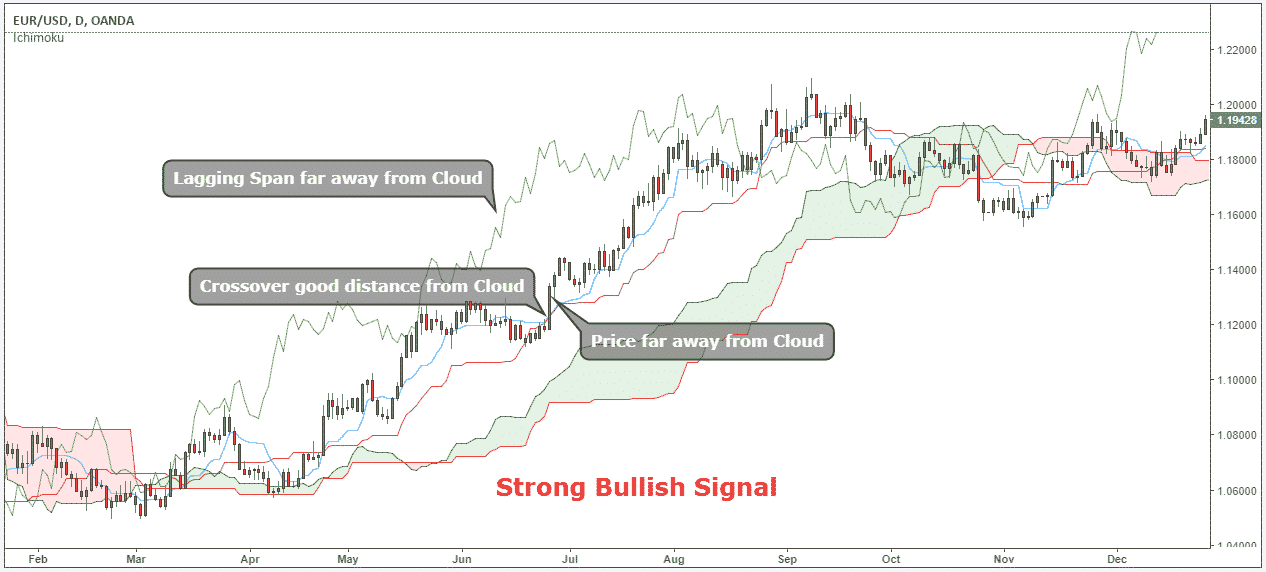
Because the many lines on the Ichimoku Cloud chart are created using an average, the chart is often compared to a simple moving average chart. However, Ichimoku is more dynamic than a simple moving average chart because it is designed to help detect changes in support and resistance.
The relationship between Leader A and Leader B will indicate whether there is a strong downtrend or an uptrend. Pay attention to both the color (green for bullish, red for bearish) and the size of the cloud. When the “cloud” between these lines is small, the trend will not be very strong.
The Ichimoku cloud is useful for day traders and others who need to make quick decisions. The cloud is often combined with other technical indicators, such as the Relative Strength Index, to give traders a complete picture of resistance and support. Many traders will also look for crossovers to determine when the trend has reversed.
Ichimoku cloud trading requires a lot of self-discipline. This is because you have to wait for the best trade signals. We will be using the default settings of the Ichimoku Cloud system.
Now let’s go a step further and learn how to make money by applying the Ichimoku trading rules.
Note * Going forward, we will not remove the Lagging Span moving average from our chart. This is because we do not base our trading decisions on as it drives down the price.
Best Ichimoku Strategy – Buying Rules
The Ichimoku cloud system is designed to keep traders on the right side of the market. Our trading rules will help you stay in the trend for as long as possible. At least until it becomes clear that a reversal is happening. The Ichimoku system is suitable for swing trading best. This is because it maximizes profits while minimizing trading risks. Here’s how to determine the right swing to increase your profits.
Best Timeframe Ichimoku Kinko Hyo is the one that suits you best. Because we don’t have a preferred timeframe.
This swing trading strategy will teach you how to follow the trend from the very beginning. You will also learn how to get as much profit as possible.
Ichimoku Cloud Trading: Step by Step
Step #1 Wait for the price to break and close above the Ichimoku Cloud.
Ichimoku Cloud Trading requires a price to trade on the Cloud. This is therefore a bullish signal and likely to start a new uptrend.
The cloud is built to highlight support and resistance levels. It highlights several layers of depth because support and resistance are not a single line drawn in the sand. It is several layers deep.
So when we break above or below the Ichimoku Cloud, it signals a profound change in market sentiment.
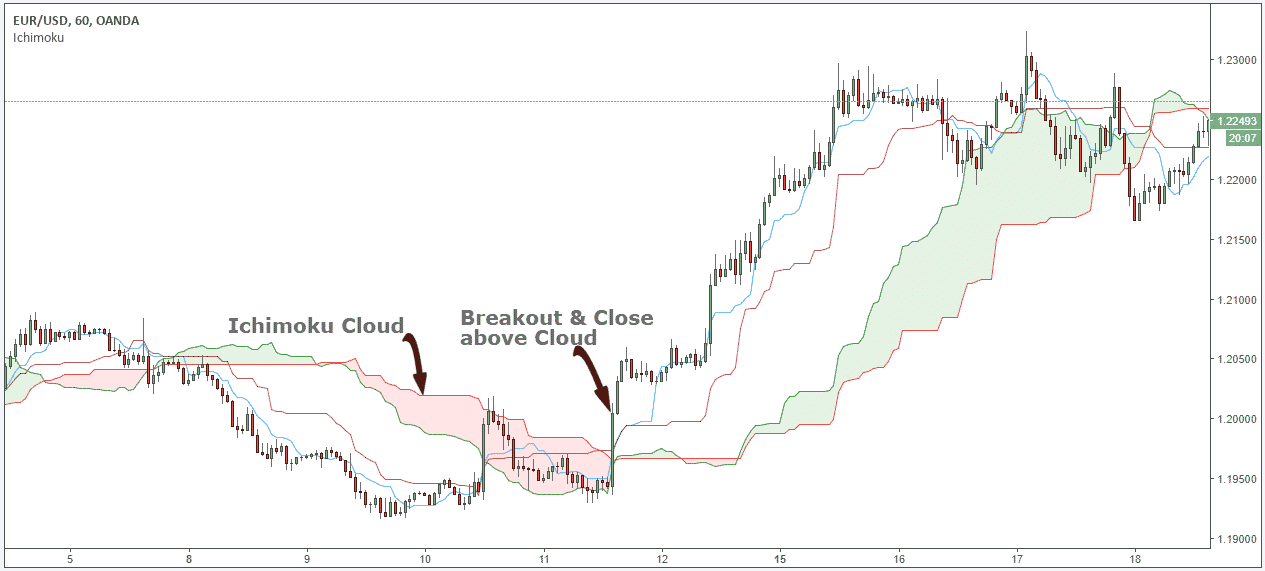
Setting up a high probability trade requires more layers of confluence before pulling the trigger.
This brings us to our next requirement for high probability trade setup.
Step #2 Wait for the crossover, the Conversion Line needs to cross above the Baseline.
The breakout in price on demand of the Cloud is followed by a transition of the Conversion Line above the Baseline. Once these two conditions are met, we can look to enter the trade.
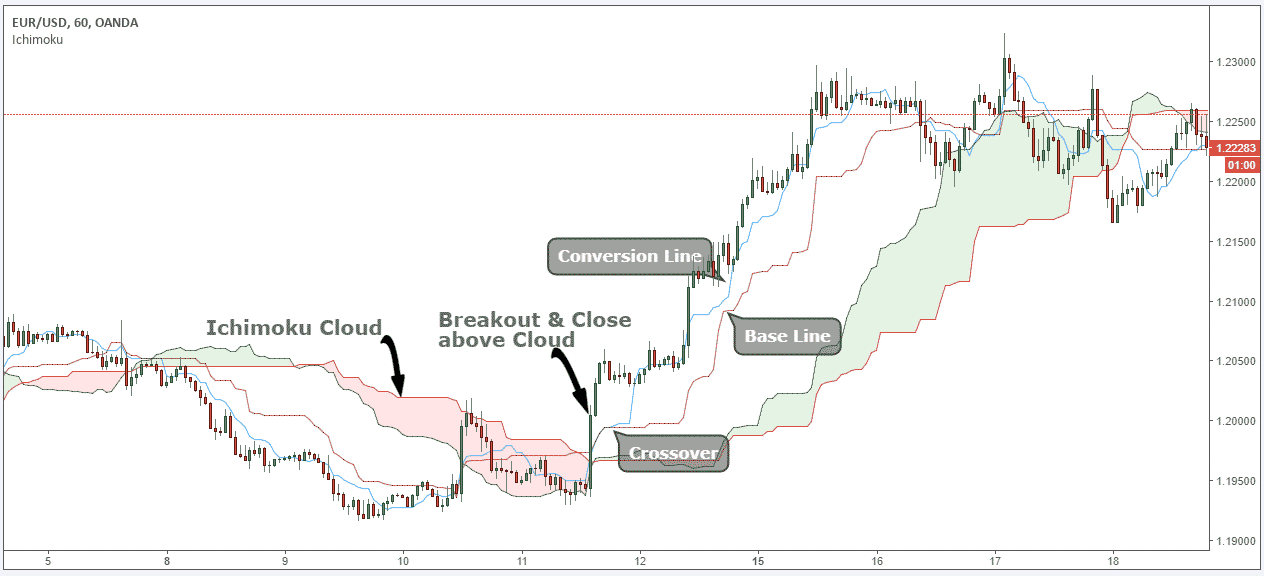
The Ichimoku Cloud Indicator is a very complex technical indicator. The indicator is even used as a moving average crossover strategy .
Now, we will show a very simple entry technique for the Ichimoku Kinko Hyo trading system.
See below….
Step #3 Buy after the crossover at the opening of the next candle.
Ideally, any long trades using the Ichimoku strategy are executed when the price is traded on the Cloud. Our team at the TSG site has adopted a more conservative approach. We have added a confluence factor before triggering a trade.
So after the crossover, we buy at the opening of the next candle.
(Note the strong buy signal in the chart below.)
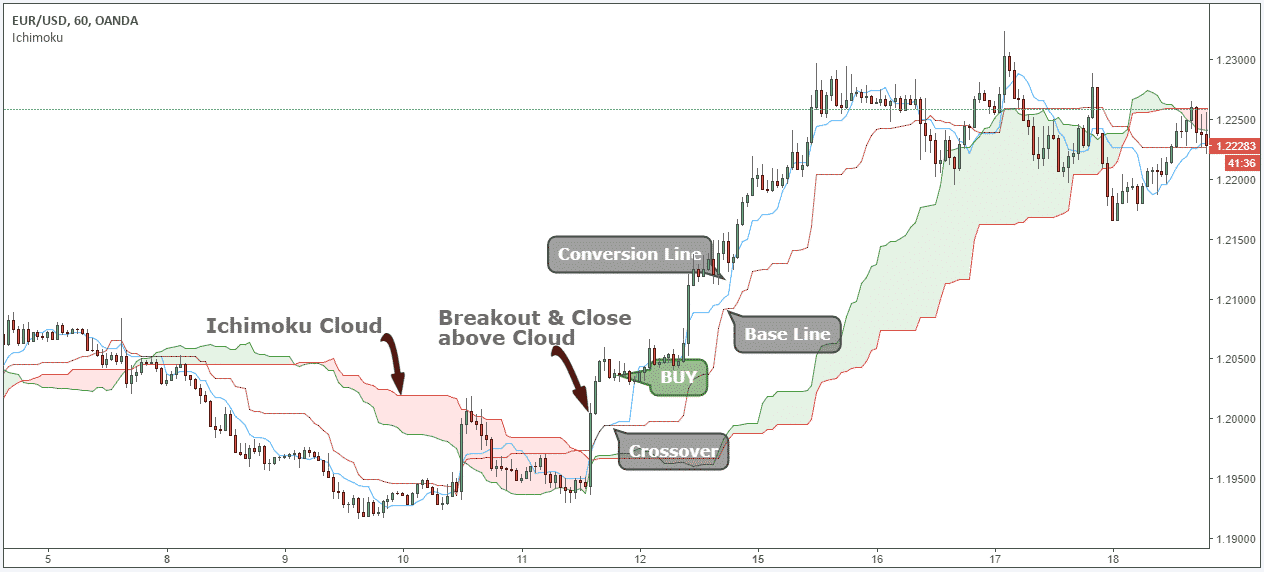
The next important thing we need to set up is where to place our protective stop.
See below…
Step #4 Place a protective stop below the breakout candle.
The ideal place to hide our protective stop is below the low of the breakout candle. This trading technique does two main things. Here is an example of a master candlestick setup.
First, it greatly reduces the risk of losing big money. Second, it helps us to trade with market order flow.

Since this is a swing trading strategy, we are looking to capture as much as possible from this perhaps new trend. We will look to trail our stop loss below the Cloud or exit the position once a new crossover occurs in the opposite direction.
The next logical thing we need to set up for the Ichimoku trading system is where to make profits.
See below…
Step #5 Take Profit when Conversion Line crosses Baseline.
We only need one simple condition to be satisfied with our profit taking strategy.
Once the conversion line crosses the baseline, we want to take profit and exit our trade.

Alternatively, you can wait until the price breaks below the Cloud, but this means risking losing part of your profits. To gain more, sometimes you have to be willing to lose some.
Note** above is an example of a BUY trade using advanced Ichimoku trading strategies. Use the same rules for SELL trades – but in reverse. In the image below you can see an example of an actual SALE transaction.
(See strong sell signal in conversion line.)

Conclusion: Explaining the Ichimoku Cloud
The best Ichimoku strategy is slightly different than probably whatever you’re used to when it comes down to technical analysis. If you are having a hard time finding real support and resistance, please apply the techniques Ichimoku cloud trading highlighted in this course.
We hope that you are now convinced that the Ichimoku Cloud system is a good way to identify trends and profit from trading any market on any timeframe. It can easily capture 80% of the trend if you follow the rules in the Ichimoku Cloud explanation .





